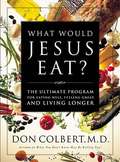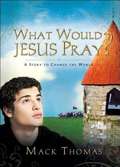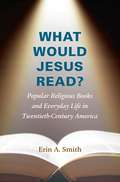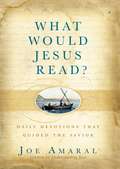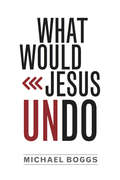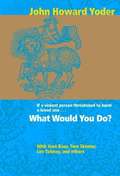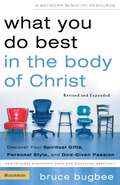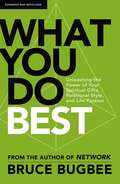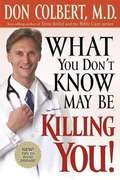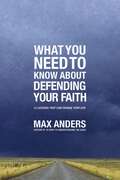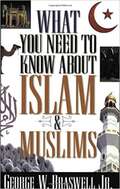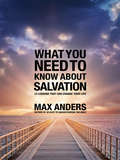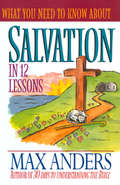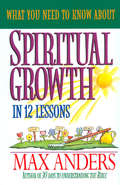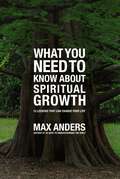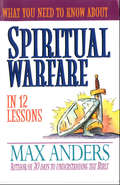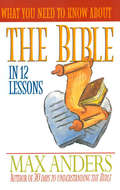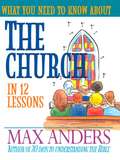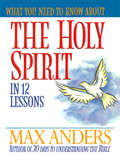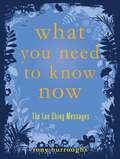- Table View
- List View
What Would Jesus Eat?: The Ultimate Program for Eating Well, Feeling Great, and Living Longer
by Don ColbertDoes Scripture teach us how to live and eat? Based on medical and historical research, this health specialist says yes! Dr. Colbert shows you why those foods Jesus ate are ideal for 21st-century living---and why those he avoided continue to pose health risks. Discover a comprehensive nutrition plan that incorporates Bible-based eating.
What Would Jesus Pray?: A Story to Change the World
by Mack ThomasYou&’re Only a Prayer Away Meet Tyson and Stefan. One strange night, they suddenly—weirdly—connect with each other in a time contortion that spans exactly a thousand years. Stefan is a young warrior in training in the Middle Ages, trapped in a tower while raiders ravage everything below. Through a long, sleepless night, the two guys help each other wrestle with responsibilities they don&’t want. And Stefan shows how to link up with a source of strength that Tyson can hardly even imagine. It all has to do with a Man named Jesus, and the way He prayed. Follow their spiritual adventure, and walk into the journey Jesus wants for you. He&’ll show you, as no one else can, how to pray in the way that works. Story Behind the Book&“This book became a reality thanks to these four things: a recurring image in my fresh-from-sleep thoughts about a boy in a bell tower, extensive Bible study on Jesus&’ prayers, the publisher&’s request for a youth book focusing on Jesus and prayer; and then a friend&’s off-hand mention of the phrase, &‘What would Jesus pray?&’&” —Mack Thomas
What Would Jesus Read?
by Erin A. SmithSince the late nineteenth century, religiously themed books in America have been commercially popular yet scorned by critics. Working at the intersection of literary history, lived religion, and consumer culture, Erin A. Smith considers the largely unexplored world of popular religious books, examining the apparent tension between economic and religious imperatives for authors, publishers, and readers. Smith argues that this literature served as a form of extra-ecclesiastical ministry and credits the popularity and longevity of religious books to their day-to-day usefulness rather than their theological correctness or aesthetic quality.Drawing on publishers' records, letters by readers to authors, promotional materials, and interviews with contemporary religious-reading groups, Smith offers a comprehensive study that finds surprising overlap across the religious spectrum--Protestant, Catholic, and Jewish, liberal and conservative. Smith tells the story of how authors, publishers, and readers reconciled these books' dual function as best-selling consumer goods and spiritually edifying literature. What Would Jesus Read? will be of interest to literary and cultural historians, students in the field of print culture, and scholars of religious studies.
What Would Jesus Read?: Daily Devotions That Guided the Savior
by Joe AmaralAfter the destruction of the first temple in Jerusalem, the Jews were exiled to Babylon. Not only was there no longer a physical place to pray, even the sacred Scriptures were becoming scarce. Many of the biblical scrolls were lost or destroyed during the exile. In an attempt to preserve the Scriptures, the Rabbis divided up the biblical texts into weekly reading portions and distributed them among the families of Israel. Each was responsible for memorizing their assigned passage and then reading it in the synagogue every Sabbath. This system of reading is the basis for the story found in Luke 4:16-17: "He went to Nazareth, where he had been brought up, and on the Sabbath day he went into the synagogue, as was his custom. And he stood up to read. The scroll of the prophet Isaiah was handed to him."This system is still in use today by Jews all over the world. In WHAT WOULD JESUS READ?, Joe Amaral gives modern day Christians the opportunity to follow and practice the same devotional system that Jesus used!
What Would Jesus Undo
by Michael BoggsWe've all heard the question, "what would Jesus do," but have you ever wondered what he would undo? The New Testament is filled with Jesus undoing anything that causes separation between God and the people he loves. What would Jesus undo in today's culture? The answer is a lot.Throughout the New Testament, Jesus undoes barriers of impotent religion (or religion that can't produce life in us), so that he can have a more intimate relationship with his people. Some of those barriers are still in existence today and they are keeping people away from God instead of drawing them closer to him.If Jesus were to actually walk into your church, your home, or your life, are there things he would undo? Sooner or later that's the question we all must wrestle with. If Jesus is undoing something in our life, we can be sure that it's for our good and for God's glory. Let the undoing begin.
What Would You Do? A Serious Answer to a Standard Question
by John H. YoderWhat would you do if someone attacked your grandmother, wife, daughter (or grandfather, husband, son)? Yoder explores the pros and cons of a nonviolent response.
What You Can Say When You Don't Know What to Say: Reaching Out to Those Who Hurt
by Lauren BriggsBeneath many smiling faces is the cry of a wounded heart- a recent sorrow, a broken romance, a serious illness, the loss of a job, financial problems, emotional stress. All are very real. All are traumatic, and those whose hearts and minds are suffering need healing and mending from the Lord. What you can say ... when you don't know what to say is your invitation to share the forgiving, healing love of Jesus Christ. This book will provide positive solutions for difficult situations and help you know how and when to share your concern and God's understanding.
What You Do Best in the Body of Christ: Discover Your Spiritual Gifts, Personal Style, and God-Given Passion
by Bruce L. BugbeeNow with discussion questions and assessment tools to help you determine your unique ministry fit. By the coauthor of the Network course materials developed at Willow Creek Community Church Have you found fulfillment in life? Can you say your ministry is fruitful? God has created you to be both fulfilled and fruitful in a meaningful place of service. You can discover your God-given design and the role he created for you in and through the local church. In What You Do Best in the Body of Christ, Bruce Bugbee helps you identify your God-given spiritual gifts, personal style, and ministry passion. And he shows how they point to your unique role and purpose in the body of Christ when they are expressed together. Drawing from biblical principles, this book provides proven tools and a conversational approach that will help you fulfill God’s will for your life. You’ll discover: Your God-given Spiritual Gifts indicate what you’re equipped to do competently Your God-given Personal Style indicates how you can serve with energy and authenticity Your God-given Ministry Passion indicates where you’re motivated to serve Together, they indicate what you do best in the body of Christ! You will also better understand God’s design for the church and your role within it. You’ll find plenty of helpful charts and self-assessments—plus insights into the fallacies and pitfalls that can hinder your effectiveness. Start learning today what God wants you to do, and experience more enthusiasm, greater joy, and real significance in your life and ministry.
What You Do Best: Unleashing the Power of Your Spiritual Gifts, Relational Style, and Life Passion
by Bruce L. BugbeeHave you found fulfillment in life?When you look at a plate, cup, or fork, you realize each has been designed and created for a different purpose. What if you could look into the mind and heart of God and see just how you have been designed and created? If you truly knew you were a "plate, cup, or fork," you would be freed from trying to be someone you are not, and free to live your life with greater faithfulness, fruitfulness, and fulfillment...making God famous!God created you to be fruitful by discovering your God-given design and the role he created for you. What You Do Best equips you to identify and express your unique contribution to this world as an integral part of your relationships, life, and ministry. The biblical principles in these pages can free you to pursue your life's calling with enthusiasm and confidence as you gain a better understanding of who God made you to be. Bruce Bugbee provides proven tools and a conversational approach that will guide you with confidence and competence toward a greater fulfillment of God's will for your life.What You Do Best provides reflection questions for each chapter that help you journal or discuss what you are learning with others, as well as Scripture passages for further study. You'll learn about the importance and use of spiritual gifts and how to identify the gifts God has given to you. You'll discover your unique relational style and uncover your life passion. What You Do Best helps you to closely examine yourself, assess your relationship with God, and reflect on what you need in order to thrive as the person you were created to be. You'll emerge from the process with a greater understanding of God, his purposes, your calling, and your role in this world. Each copy of the book includes access to three online self-assessments that help you to identify your unique spiritual gifts, relational style, and life passion.
What You Don't Know May Be Killing You
by Don ColbertYou know that proper diet, exercise, and rest can keep you in good health, but perhaps you wonder if you're doing enough. Perhaps you've seen family members and friends who took care of themselves devastated by illness. Was there something they could have done to prevent the disease or illness. The truth is...what you don't know may be killing you. Dr. Don Colbert's answers and updated information may surprise you AND help you!
What You Don't Know May Be Killing You: Tips to Avoid Disease
by Don ColbertMAKE BETTER HEALTH DECISIONS FOR YOU AND YOUR FAMILY. You already know that proper diet, exercise, controlling your environment and rest can keep you in good health. But you're still not sure you're doing enough. You may have seen family or friends devastated by illness-even those who took great care of themselves. Could they have done more to prevent disease? What they did probably helped. But there's more to creating and sustaining good health than you may know. The truth is... WHAT YOU DON'T KNOW MAY BE KILLING YOU!Dr. Don Colbert faced personal health struggles, and when his own profession was unable to give him answers or help, he turned to more natural health-related disciplines. The answers he found surprised him then, and this new, updated information may surprise you today!
What You Need to Know About Bible Prophecy in 12 Lessons
by Max AndersProphets. Rapture. Tribulation. Judgment. End times. Learn what the Bible has to say about prophecy, how Christians differ in their views of the end times, and what the universals are on which all Christians agree.
What You Need to Know About Defending Your Faith in 12 Lessons: The What You Need to Know Study Guide Series
by Max AndersToday believers encounter a dizzying array of religious options. What You Need to Know About Defending your Faith gives every believer who wants answers complete training that will firm up their faith and provide confidence in sharing the gospel.
What You Need to Know About Islam and Muslims
by George BraswellGeared toward both the student and the interested general reader, What You Need to Know About Islam and Muslims is an all-you-need-to-know-and-more book about the Islam. Written in simple language, this book describes to Christians the story of Islam and the Muslim people, and their aggressive plans to establish Islam in every culture.
What You Need to Know About Salvation
by Max AndersBad news first: everyone is born lost. Now the good news: Jesus saves! Simple enough. But today's secular and new age optimism blinds many to the reality that we need a Savior. And even some who come to Christ don't fully understand the stupendous treasure God gives when He saves them. What You Need to Know about Salvation will fortify your confidence in the salvation you've received and help you experience more of its infinite riches. You'll thrill at the drama of redemption as it unfolds through Scripture: the glory of creation, the tragedy of sin and the Fall, the provision of salvation in Jesus Christ, and its application today through the Holy Spirit. And you'll be moved to worship your Savior and share the good news with others. Features include: 12 lessons you can complete in under one hour each Real-life application of biblical truth Explanations of prominent Christian views on the topic Easy-to-teach resources, including previews and summary features Questions for discussion Core teachings on Christianity that will challenge any seeker, new believer, or veteran believer looking for a stronger foundation What You Need to Know study guides sold to date: More than 200,000
What You Need to Know About Salvation in 12 Lessons
by Max AndersChristianity begins with the bad news that all are spiritually lost and then announces the good news that Jesus saves those who trust Him. What You Need to Know About Salvation explores the provision of salvation in Jesus Christ, its application today through the Holy Spirit, and its consummation at the Second Coming.
What You Need to Know About Spiritual Growth in 12 Lessons
by Max AndersLearn the ways God wants us to grow as Christians and how to cooperate with Him through the disciplines of grace. Spiritual Growth shows you how to grow and the many resources God provides to nurture you.
What You Need to Know About Spiritual Growth: 12 Lessons That Can Change Your Life
by Max AndersDiscover the exciting growth plan for your life! Find out how God can use anything in your life to help you become more like His Son, Jesus Christ. Explore God's abundant resources that nourish you--His Spirit, the Bible, the church, time and challenges, and the spiritual disciplines--proven paths to a fruitful life. Learn how God speaks to believers and empowers them to overcome entrenched sins. What You Need to Know about Spiritual Growth will help you grow in Christ--secure in His love, strong in His grace, and seasoned to persevere for daily victories and joyful service to others. Features include: 12 lessons you can complete in under 1 hour each Real-life application of biblical truth Explanations of prominent Christian views on the topic Easy-to-teach resources, including previews and summary features Questions for discussion Core teachings on Christianity that will challenge any seeker, new believer, or veteran believer looking for a stronger foundation What You Need to Know About study guides sold to date: More than 200,000
What You Need to Know About Spiritual Warfare in 12 Lessons
by Max AndersThere is a great deal of talk today about the supernatural. Spiritual Warfare outlines what the Bible says about angels, demons, and Satan as well as how God overcomes the world and will equip you to fight the good fight of faith.
What You Need to Know About the Bible in 12 Lessons
by Max AndersGod has spoken and still speaks to His people through His written word. Anders shows how to use the Bible for devotion, for study, and for effective living.
What You Need to Know About the Church in 12 Lessons
by Max AndersFind and fill your important place in God's church more effectively than ever. Let The Church show you how God unites all true believers in His body and what on earth He's been doing through His people.
What You Need to Know About the Holy Spirit in 12 Lessons
by Max AndersMany Christians desire to know and understand the Holy Spirit personally. This volume offers understanding about the third person of the Trinity and helps believers grow in their relationship with Him.
What You Need to Know Now: The Lee Ching Messages
by Tony BurroughsThe world is changing all around us with increasing speed, making most of us feel we have no control. Through the art of Intending, you can take control of your own destiny and create your ideal life. The author of several bestsellers, Tony Burroughs has taught over 2 million people how to get exactly what they want for themselves, their loved ones, and the planet. Now, for the first time, Tony reveals the secrets from the very source in this revelatory text. Tony Burroughs was a young man living in Hawaii when an older philosopher sage took him under his wing and became his mentor at an exotic fruit farm on the Big Island. Over a period of ten years, Tony learned "The Information," a series of oral lessons comprising a body of deep teachings about the meaning of life, the history of mankind, and how to evolve and live a meaningful life filled with love, peace, and abundance. A core teaching was intention-setting, and Tony and two friends started a weekly circle to try it out. This first humble circle of three people had life-changing effects, resulting in Tony Burroughs's lifelong mission to guide others.
What You Practice Is What You Have: A Guide to Having the Life You Want
by Cheri HuberOur lives are the result of what we practice. For example, if we practice "chasing after money" or "I'm overwhelmed with work" or "things should be different," that's the life experience we will have. Focusing on "something wrong" and "not enough" will create a life of lack or failure. If we want our lives to be different, we must practice the difference we want. To have a different practice we must 1) recognize our current practice, 2) clarify the practice we want instead, and 3) learn to practice moment by moment what we choose. The sequel to Cheri Huber' s perennial best seller There Is Nothing Wrong with You: Going Beyond Self-Hate, this book further exposes with clarity and humor the antics of mental conditioning and self-hate. It introduces the powerful practice of Recording and Listening with tools and techniques to develop the relationship with the Wisdom, Love and Compassion that allow us to transcend self-hate.
What You Think of Me is None of My Business
by Terry Cole-WhittakerYou have a God-given right to happiness, wealth, and success. In this dynamic book by Reverend Terry Cole-Whittaker, you’ll learn how to cast off the shackles of fear and false beliefs to discover your own inner path—the route to your inborn talents and limitless potential! <P><P> Explore your deepest feelings with self-awareness strategies and consciousness-raising exercises. Learn how to cope with physical, mental, and spiritual problems, involving love, money, risk-taking, relationships, guilt, self-reliance, self-image, sexuality, and more. It’s all here in one astonishing book: the motivation, tools, and tactics to resolve personal conflicts—and change your life forever!
